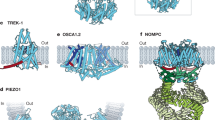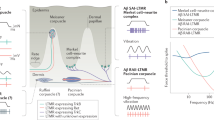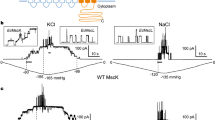Abstract
Mechanotransduction — a cell's conversion of a mechanical stimulus into an electrical signal — reveals vital features of an organism's environment. From hair cells and skin mechanoreceptors in vertebrates, to bristle receptors in flies and touch receptors in worms, mechanically sensitive cells are essential in the life of an organism. The scarcity of these cells and the uniqueness of their transduction mechanisms have conspired to slow molecular characterization of the ensembles that carry out mechanotransduction. But recent progress in both invertebrates and vertebrates is beginning to reveal the identities of proteins essential for transduction.
This is a preview of subscription content, access via your institution
Access options
Subscribe to this journal
Receive 51 print issues and online access
$199.00 per year
only $3.90 per issue
Buy this article
- Purchase on Springer Link
- Instant access to full article PDF
Prices may be subject to local taxes which are calculated during checkout




Similar content being viewed by others
References
Chalfie, M. A molecular model for mechanosensation in Caenorhabditis elegans. Biol. Bull. 192, 125–130 (1997).
Tavernarakis, N. & Driscoll, M. Molecular modeling of mechanotransduction in the nematode Caenorhabditis elegans. Annu. Rev. Physiol. 59, 659–689 (1997).
Hudspeth, A. J. Hair-bundle mechanics and a model for mechanoelectrical transduction by hair cells. Soc. Gen. Physiol. Ser. 47, 357–370 (1992).
Narins, P. M. & Lewis, E. R. The vertebrate ear as an exquisite seismic sensor. J. Acoust. Soc. Am. 76, 1384–1387 (1984).
Sukharev, S. I., Blount, P., Martinac, B., Blattner, F. R. & Kung, C. A large-conductance mechanosensitive channel in E. coli encoded by mscL alone. Nature 368, 265–268 (1994).
Kloda, A. & Martinac, B. Molecular identification of a mechanosensitive channel in archaea. Biophys. J. 80, 229–240 (2001).
Chalfie, M. & Sulston, J. Developmental genetics of the mechanosensory neurons of Caenorhabditis elegans. Dev. Biol. 82, 358–370 (1981).
Chalfie, M. & Au, M. Genetic control of differentiation of the Caenorhabditis elegans touch receptor neurons. Science 243, 1027–1033 (1989).
Duggan, A., Ma, C. & Chalfie, M. Regulation of touch receptor differentiation by the Caenorhabditis elegans mec-3 and unc-86 genes. Development 125, 4107–4119 (1998).
Way, J. C. & Chalfie, M. mec-3, a homeobox-containing gene that specifies differentiation of the touch receptor neurons in C. elegans. Cell 54, 5–16 (1988).
Savage, C. et al. mec-7 is a beta-tubulin gene required for the production of 15-protofilament microtubules in Caenorhabditis elegans. Genes Dev. 3, 870–881 (1989).
Fukushige, T. et al. MEC-12, an α-tubulin required for touch sensitivity in C. elegans. J. Cell Sci. 112, 395–403 (1999).
Huang, M., Gu, G., Ferguson, E. L. & Chalfie, M. A stomatin-like protein necessary for mechanosensation in C. elegans. Nature 378, 292–295 (1995).
Du, H., Gu, G., William, C. M. & Chalfie, M. Extracellular proteins needed for C. elegans mechanosensation. Neuron 16, 183–194 (1996).
Gu, G., Caldwell, G. A. & Chalfie, M. Genetic interactions affecting touch sensitivity in Caenorhabditis elegans. Proc. Natl Acad. Sci. USA 93, 6577–6582 (1996).
Alvarez de la Rosa, D., Canessa, C. M., Fyfe, G. K. & Zhang, P. Structure and regulation of amiloride-sensitive sodium channels. Annu. Rev. Physiol. 62, 573–594 (2000).
Garcia-Anoveros, J., Ma, C. & Chalfie, M. Regulation of Caenorhabditis elegans degenerin proteins by a putative extracellular domain. Curr. Biol. 5, 441–448 (1995).
Huang, M. & Chalfie, M. Gene interactions affecting mechanosensory transduction in Caenorhabditis elegans. Nature 367, 467–470 (1994).
Garcia-Anoveros, J., Garcia, J. A., Liu, J. D. & Corey, D. P. The nematode degenerin UNC-105 forms ion channels that are activated by degeneration- or hypercontraction-causing mutations. Neuron 20, 1231–1241 (1998).
Kizer, N., Guo, X. L. & Hruska, K. Reconstitution of stretch-activated cation channels by expression of the α-subunit of the epithelial sodium channel cloned from osteoblasts. Proc. Natl Acad. Sci. USA 94, 1013–1018 (1997).
Adams, C. M. et al. Ripped pocket and pickpocket, novel Drosophila DEG/ENaC subunits expressed in early development and in mechanosensory neurons. J. Cell Biol. 140, 143–152 (1998).
Drummond, H. A., Price, M. P., Welsh, M. J. & Abboud, F. M. A molecular component of the arterial baroreceptor mechanotransducer. Neuron 21, 1435–1441 (1998).
Garcia-Anoveros, J., Samad, T. A., Woolf, C. J. & Corey, D. P. Transport and localization of the DEG/ENaC ion channel BNaC1α to peripheral mechanosensory terminals of dorsal root ganglia neurons. J. Neurosci. 21, 2678–2686 (2001).
Price, M. P. et al. The mammalian sodium channel BNC1 is required for normal touch sensation. Nature 407, 1007–1011 (2000).
Fricke, B. et al. Epithelial Na+ channels and stomatin are expressed in rat trigeminal mechanosensory neurons. Cell Tissue Res. 299, 327–334 (2000).
Drummond, H. A., Abboud, F. M. & Welsh, M. J. Localization of beta and gamma subunits of ENaC in sensory nerve endings in the rat foot pad. Brain Res. 884, 1–12 (2000).
Hummler, E. & Horisberger, J. D. Genetic disorders of membrane transport. V. The epithelial sodium channel and its implication in human diseases. Am. J. Physiol. 276, G567–G571 (1999).
Kernan, M., Cowan, D. & Zuker, C. Genetic dissection of mechanosensory transduction: mechanoreception—defective mutations of Drosophila. Neuron 12, 1195–1206 (1994).
Walker, R. G., Willingham, A. T. & Zuker, C. S. A Drosophila mechanosensory transduction channel. Science 287, 2229–2234 (2000).
Eberl, D. F., Hardy, R. W. & Kernan, M. J. Genetically similar transduction mechanisms for touch and hearing in Drosophila. J. Neurosci. 20, 5981–5988 (2000).
Chung, Y. D., Zhu, J., Han, Y. & Kernan, M. J. nompA encodes a PNS-specific, ZP domain protein required to connect mechanosensory dendrites to sensory structures. Neuron 29, 415–428 (2001).
Legan, P. K., Rau, A., Keen, J. N. & Richardson, G. P. The mouse tectorins. Modular matrix proteins of the inner ear homologous to components of the sperm-egg adhesion system. J. Biol. Chem. 272, 8791–8801 (1997).
Sedgwick, S. G. & Smerdon, S. J. The ankyrin repeat: a diversity of interactions on a common structural framework. Trends Biochem. Sci. 24, 311–316 (1999).
Rubtsov, A. M. & Lopina, O. D. Ankyrins. FEBS Lett. 482, 1–5 (2000).
Colbert, H. A., Smith, T. L. & Bargmann, C. I. OSM-9, a novel protein with structural similarity to channels, is required for olfaction, mechanosensation, and olfactory adaptation in Caenorhabditis elegans. J. Neurosci. 17, 8259–8269 (1997).
Liedtke, W. et al. Vanilloid receptor-related osmotically activated channel (VR-OAC), a candidate vertebrate osmoreceptor. Cell 103, 525–535 (2000).
Schweisguth, F., Gho, M. & Lecourtois, M. Control of cell fate choices by lateral signaling in the adult peripheral nervous system of Drosophila melanogaster. Dev. Genet. 18, 28–39 (1996).
Adam, J. et al. Cell fate choices and the expression of Notch, Delta and Serrate homologues in the chick inner ear: parallels with Drosophila sense-organ development. Development 125, 4645–4654 (1998).
Bermingham, N. A. et al. Math1: an essential gene for the generation of inner ear hair cells. Science 284, 1837–1841 (1999).
Ben-Arie, N. et al. Functional conservation of atonal and Math1 in the CNS and PNS. Development 127, 1039–1048 (2000).
Corey, D. P. & Hudspeth, A. J. Kinetics of the receptor current in bullfrog saccular hair cells. J. Neurosci. 3, 962–976 (1983).
van Netten, S. M. & Kros, C. J. Gating energies and forces of the mammalian hair cell transducer channel and related hair bundle mechanics. Proc. R. Soc. Lond. B 267, 1915–1923 (2000).
Pickles, J. O., Comis, S. D. & Osborne, M. P. Cross-links between stereocilia in the guinea pig organ of Corti, and their possible relation to sensory transduction. Hearing Res. 15, 103–112 (1984).
Kachar, B., Parakkal, M., Kurc, M., Zhao, Y. & Gillespie, P. G. High-resolution structure of hair-cell tip links. Proc. Natl Acad. Sci. USA 97, 13336–13341 (2000).
Corey, D. P. & Hudspeth, A. J. Ionic basis of the receptor potential in a vertebrate hair cell. Nature 281, 675–677 (1979).
Crawford, A. C., Evans, M. G. & Fettiplace, R. The actions of calcium on the mechano-electrical transducer current of turtle hair cells. J. Physiol. 434, 369–398 (1991).
Ricci, A. J. & Fettiplace, R. Calcium permeation of the turtle hair cell mechanotransducer channel and its relation to the composition of endolymph. J. Physiol. 506, 159–173 (1998).
Kroese, A. B., Das, A. & Hudspeth, A. J. Blockage of the transduction channels of hair cells in the bullfrog's sacculus by aminoglycoside antibiotics. Hear Res. 37, 203–217 (1989).
Rusch, A., Kros, C. J. & Richardson, G. P. Block by amiloride and its derivatives of mechano-electrical transduction in outer hair cells of mouse cochlear cultures. J. Physiol. 474, 75–86 (1994).
Sand, O. Effects of different ionic environments on the mechano-sensitivity of the lateral line organs in the mudpuppy. J. Comp. Physiol. A 102, 27–42 (1975).
Glowatzki, E., Ruppersberg, J. P., Zenner, H. P. & Rusch, A. Mechanically and ATP-induced currents of mouse outer hair cells are independent and differentially blocked by d-tubocurarine. Neuropharmacology 36, 1269–1275 (1997).
Baumann, M. & Roth, A. The Ca2+ permeability of the apical membrane in neuromast hair cells. J. Comp. Physiol. 158, 681–688 (1986).
Jorgensen, F. & Kroese, A. B. Ca selectivity of the transduction channels in the hair cells of the frog sacculus. Acta Physiol. Scand. 155, 363–376 (1995).
Rusch, A. & Hummler, E. Mechano-electrical transduction in mice lacking the alpha-subunit of the epithelial sodium channel. Hear Res. 131, 170–176 (1999).
Housley, G. D. et al. Expression of the P2X2 receptor subunit of the ATP-gated ion channel in the cochlea: implications for sound transduction and auditory neurotransmission. J. Neurosci. 19, 8377–8388 (1999).
Housley, G. D., Luo, L. & Ryan, A. F. Localization of mRNA encoding the P2X2 receptor subunit of the adenosine 5′-triphosphate-gated ion channel in the adult and developing rat inner ear by in situ hybridization. J. Comp. Neurol. 393, 403–414 (1998).
Kros, C. J., Rüsch, A. & Richardson, G. P. Mechano-electrical transducer currents in hair cells of the cultured neonatal mouse cochlea. Proc. R. Soc. Lond. B 249, 185–193 (1992).
Harteneck, C., Plant, T. D. & Schultz, G. From worm to man: three subfamilies of TRP channels. Trends Neurosci. 23, 159–166 (2000).
Hudspeth, A. J. & Gillespie, P. G. Pulling springs to tune transduction: adaptation by hair cells. Neuron 12, 1–9 (1994).
Howard, J. & Hudspeth, A. J. Mechanical relaxation of the hair bundle mediates adaptation in mechanoelectrical transduction by the bullfrog's saccular hair cell. Proc. Natl Acad. Sci. USA 84, 3064–3068 (1987).
Steel, K. P. & Kros, C. J. A genetic approach to understanding auditory function. Nature Genet. 27, 143–149 (2001).
Liu, J., Schrank, B. & Waterston, R. H. Interaction between a putative mechanosensory membrane channel and a collagen. Science 273, 361–364 (1996).
Ricci, A. J. & Fettiplace, R. The effects of calcium buffering and cyclic AMP on mechano-electrical transduction in turtle auditory hair cells. J. Physiol. 501, 111–124 (1997).
Benser, M. E., Marquis, R. E. & Hudspeth, A. J. Rapid, active hair bundle movements in hair cells from the bullfrog's sacculus. J. Neurosci. 16, 5629–5643 (1996).
Ricci, A. J., Crawford, A. C. & Fettiplace, R. Active hair bundle motion linked to fast transducer adaptation in auditory hair cells. J. Neurosci. 20, 7131–7142 (2000).
Martin, P., Mehta, A. D. & Hudspeth, A. J. Negative hair-bundle stiffness betrays a mechanism for mechanical amplification by the hair cell. Proc. Natl Acad. Sci. USA 97, 12026–12031 (2000).
Gillespie, P. G. & Corey, D. P. Myosin and adaptation by hair cells. Neuron 19, 955–958 (1997).
Richardson, G. P. et al. A missense mutation in myosin VIIA prevents aminoglycoside accumulation in early postnatal cochlear hair cells. Ann. NY Acad. Sci. 884, 110–124 (1999).
Gillespie, P. G. & Hudspeth, A. J. High-purity isolation of bullfrog hair bundles and subcellular and topological localization of constituent proteins. J. Cell Biol. 112, 625–640 (1991).
Gibson, F. et al. A type VII myosin encoded by the mouse deafness gene shaker-1. Nature 374, 62–64 (1995).
Self, T. et al. Shaker-1 mutations reveal roles for myosin VIIA in both development and function of cochlear hair cells. Development 125, 557–566 (1998).
Ernest, S. et al. Mariner is defective in myosin VIIA: a zebrafish model for human hereditary deafness. Hum. Mol. Genet. 9, 2189–2196 (2000).
Hasson, T. et al. Unconventional myosins in inner-ear sensory epithelia. J. Cell Biol. 137, 1287–1307 (1997).
Bolz, H. et al. Mutation of CDH23, encoding a new member of the cadherin gene family, causes Usher syndrome type 1D. Nature Genet. 27, 108–112 (2001).
Di Palma, F. et al. Mutations in Cdh23, encoding a new type of cadherin, cause stereocilia disorganization in waltzer, the mouse model for Usher syndrome type 1D. Nature Genet. 27, 103–107 (2001).
Ahmed, Z. M. et al. Mutations of the protocadherin gene PCDH15 cause Usher syndrome type 1F. Am. J. Hum. Genet. 69, 25–34 (2001).
Alagramam, K. N. et al. Mutations in the novel protocadherin PCDH15 cause Usher syndrome type 1F. Hum. Mol. Genet. 10, 1709–1718 (2001).
Alagramam, K. N. et al. The mouse Ames waltzer hearing-loss mutant is caused by mutation of Pcdh15, a novel protocadherin gene. Nature Genet. 27, 99–102 (2001).
Eudy, J. D. et al. Mutation of a gene encoding a protein with extracellular matrix motifs in Usher syndrome type IIa. Science 280, 1753–1757 (1998).
Kussel-Andermann, P. et al. Unconventional myosin VIIA is a novel A-kinase-anchoring protein. J. Biol. Chem. 275, 29654–29659 (2000).
Kussel-Andermann, P. et al. Vezatin, a novel transmembrane protein, bridges myosin VIIA to the cadherin-catenins complex. EMBO J. 19, 6020–6029 (2000).
Self, T. et al. Role of myosin VI in the differentiation of cochlear hair cells. Dev. Biol. 214, 331–341 (1999).
Lechler, T., Shevchenko, A. & Li, R. Direct involvement of yeast type I myosins in Cdc42-dependent actin polymerization. J. Cell Biol. 148, 363–373 (2000).
Zhao, Y., Yamoah, E. N. & Gillespie, P. G. Regeneration of broken tip links and restoration of mechanical transduction in hair cells. Proc. Natl Acad. Sci. USA 93, 15469–15474 (1996).
Kozel, P. J. et al. Balance and hearing deficits in mice with a null mutation in the gene encoding plasma membrane Ca2+-ATPase isoform 2. J. Biol. Chem. 273, 18693–18696 (1998).
Street, V. A., McKee-Johnson, J. W., Fonseca, R. C., Tempel, B. L. & Noben-Trauth, K. Mutations in a plasma membrane Ca2+-ATPase gene cause deafness in deafwaddler mice. Nature Genet. 19, 390–394 (1998).
Takahashi, K. & Kitamura, K. A point mutation in a plasma membrane Ca2+-ATPase gene causes deafness in Wriggle Mouse Sagami. Biochem. Biophys. Res. Commun. 261, 773–778 (1999).
Dumont, R. et al. Plasma membrane Ca2+-ATPase isoform 2a is the PMCA of hair bundles. J. Neurosci. 21, 5066–5078 (2001).
Yamoah, E. N. et al. Plasma membrane Ca2+-ATPase extrudes Ca2+ from hair cell stereocilia. J. Neurosci. 18, 610–624 (1998).
Shepherd, G. M. G., Barres, B. A. & Corey, D. P. “Bundle-blot” purification and initial protein characterization of hair cell stereocilia. Proc. Natl Acad. Sci. USA 86, 4973–4977 (1989).
Walker, R. G., Hudspeth, A. J. & Gillespie, P. G. Calmodulin and calmodulin-binding proteins in hair bundles. Proc. Natl Acad. Sci. USA 90, 2807–2811 (1993).
Walker, R. G. & Hudspeth, A. J. Calmodulin controls adaptation of mechanoelectrical transduction by hair cells of the bullfrog's sacculus. Proc. Natl Acad. Sci. USA 93, 2203–2207 (1996).
Noben-Trauth, K., Zheng, Q. Y., Johnson, K. R. & Nishina, P. M. mdfw: a deafness susceptibility locus that interacts with deaf waddler (dfw). Genomics 44, 266–272 (1997).
Flock, A., Cheung, H. C., Flock, B. & Utter, G. Three sets of actin filaments in sensory cells of the inner ear. Identification and functional orientation determined by gel electrophoresis, immunofluorescence/electron microscopy. J. Neurocytol. 10, 133–147 (1981).
Tilney, M. S. et al. Preliminary biochemical characterization of the stereocilia and cuticular plate of hair cells of the chick cochlea. J. Cell Biol. 109, 1711–1723 (1989).
Zheng, L. et al. The deaf jerker mouse has a mutation in the gene encoding the espin actin-bundling proteins of hair cell stereocilia and lacks espins. Cell 102, 377–385 (2000).
Lynch, E. D. et al. Nonsyndromic deafness DFNA1 associated with mutation of a human homolog of the Drosophila gene diaphanous. Science 278, 1315–1318 (1997).
Author information
Authors and Affiliations
Corresponding author
Rights and permissions
About this article
Cite this article
Gillespie, P., Walker, R. Molecular basis of mechanosensory transduction. Nature 413, 194–202 (2001). https://doi.org/10.1038/35093011
Issue Date:
DOI: https://doi.org/10.1038/35093011
This article is cited by
-
Whole-exome sequencing reveals genetic variants that may play a role in neurocytomas
Journal of Neuro-Oncology (2024)
-
Examining Mechanisms for Voltage-Sensitive Calcium Channel-Mediated Secretion Events in Bone Cells
Calcified Tissue International (2023)
-
A small molecule screen identifies novel inhibitors of mechanosensory nematocyst discharge in Hydra
Scientific Reports (2021)
-
Wnt/β-catenin signaling pathway in uterine leiomyoma: role in tumor biology and targeting opportunities
Molecular and Cellular Biochemistry (2021)
-
Cell shape: effects on gene expression and signaling
Biophysical Reviews (2020)
Comments
By submitting a comment you agree to abide by our Terms and Community Guidelines. If you find something abusive or that does not comply with our terms or guidelines please flag it as inappropriate.



